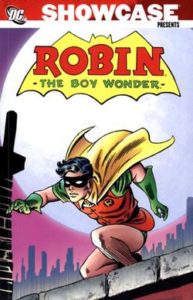Comic Book Review: Showcase Presents Robin the Boy Wonder Vol. 1 by various creators
In 1940, a year after Batman debuted, he gained the first superhero kid sidekick in comic books. Robin aka Dick Grayson served several functions. Kid appeal, merchandising, lightening up the tone of the stories a bit, and giving Batman someone to have dialogue with to explain what was going on in the plot. Robin was a success, inspiring many kid sidekicks for decades to come.
This volume opens with a revamp of the origin published in 1969. The Flying Graysons are a family of acrobats and trapeze artists working for the Haly Circus. When Mr. Haly, the owner and ringmaster, refuses to pay “protection money” to Boss Zucco, the gangster has the Grayson parents murdered in an “accident.” Dick wants revenge, but is approached by Batman, who’s been investigating Boss Zucco.
Orphaned by crime himself, Bruce Wayne takes in Dick and as Batman trains the boy in crimefighting. Armed with his new knowledge, Robin is able to assist Batman in ensuring Zucco is convicted for his crimes, and gets the closure Batman himself wouldn’t receive for years. Dick chooses to stay Robin, both out of a sense of justice, and because he likes being a caped crusader.
Robin had a number of solo adventure in the Golden Age comics, but none of them are reprinted here. Instead we pick up in 1964 as Dick teams up several times with Jimmy Olsen, Superman’s pal in the pages of World’s Finest. Both Robin and Jimmy had what might be called “vague age”, varying between junior high age and nearly college age depending on the needs of the story.
Shortly thereafter, Robin started having sporadic solo outings as a backup feature in the Batman comics. His age was firmed up as being in late high school, and Dick got his own supporting cast. In 1969, as the Batman comics were going through one of their periodic revamps, Dick finally graduated from high school and went to Hudson University across the state from Gotham City.
For the most part, these stories are decently written and have okay art. A few are quite clever. One running theme is Robin’s tendency to jump to conclusions and having to correct course mid-story. Which has its good points as a way to move the plot along, but you’d think Dick would learn.
Another noticeable theme was that as DC’s products entered their “relevance” phase, Robin’s solo stories were used to highlight issues relevant to “the youth.” Except that since most of DC’s creative and editorial staff had been working in comics since the 1940s, they really weren’t much in tune with the actual teens and college students of the time. This resulted in stories where the establishment was misunderstood by the rebellious youth rather than being the cause of the problems. (In one instance, it turns out student protesters are the dupes of foreign agents trying to destroy faith in America’s educational system!)
The better stories acknowledge that Dick Grayson isn’t really representative of youth culture, having spent most of his adolescence training in and participating in crimefighting, and otherwise insulated from most of the country’s ills by his mentor’s wealth. Robin’s a good person, and a hero, but he’s a square. He too has to learn what’s really going on.
Clashing with this direction for Robin is the story in Justice League of America #91-92, which is one of the periodic Justice League/Justice Society team-ups. It has both the current Robin and the Robin of Earth-Two (who had had all the Golden Age adventures in the continuity of that time) being patronized by their respective teams. This made a little sense for the JLA as their Robin was officially barely college age, despite having been in the hero business longer than several of them, but not so much for the JSA, since that was a group of men in their fifties and early sixties denigrating a man in his forties.
There are a couple of appearances from members of the Teen Titans, though not as a group as it had been disbanded, and wouldn’t reform until after the last story in this volume printed in 1975. One resolves a short-lived subplot about a girl with psychic powers, but not in a satisfying way. “Now that we’ve found each other, we must not ever be in the same place!”
Dick Grayson would eventually drop the Robin moniker in deference to other Batman sidekicks, and mature into a new identity, Nightwing.
This volume is primarily for Dick Grayson fans on a budget; check out your local libraries for copies to see how the character has evolved over the years.

